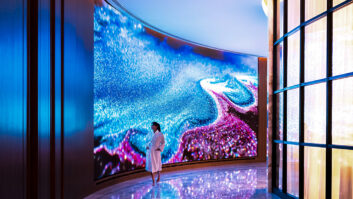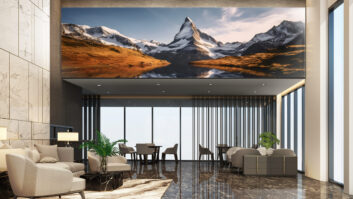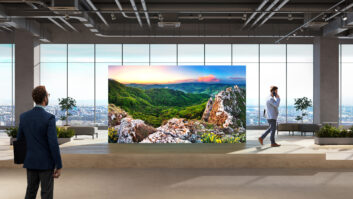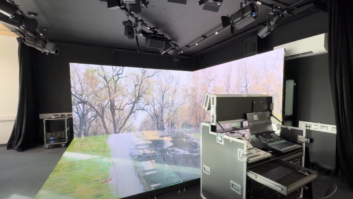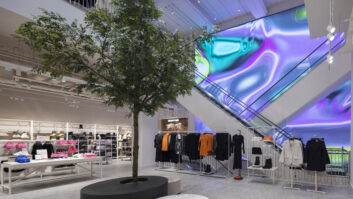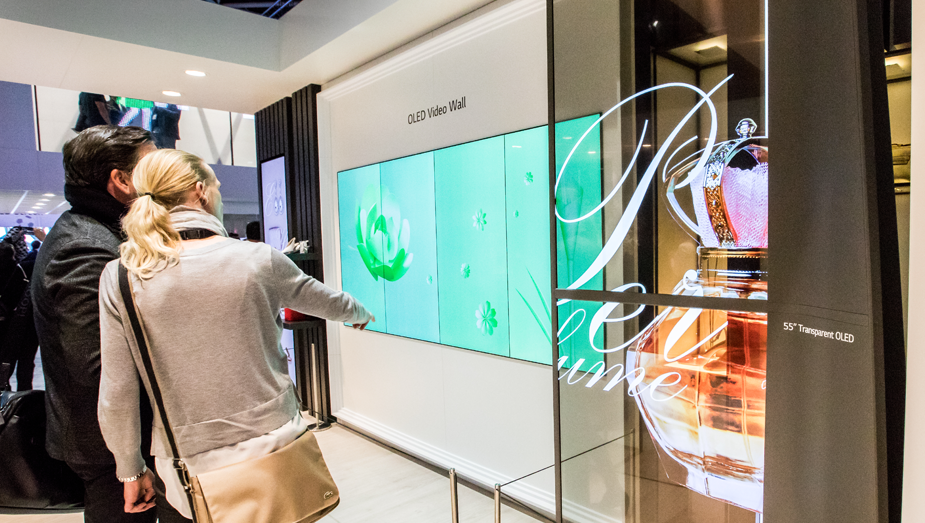
In the first part of this feature on the future of displays, we outlined some of the emerging technologies set to have an impact. Here manufacturers make the case for the improvement of existing formats and remark on the increase in creativity of content, unusual shapes and multi-screen formations.
Thomas Issa, corporate and education solution marketing manager for Sony Professional Solutions Europe suggests that there is still a lot of life left in the current types of display. “While there are some superb solutions on the market already, both LED and LCD technologies still have a lot of room to grow before we need to start thinking about the next big innovations. There is scope for a number of advances: from improving resolution and picture quality, to creating new designs with reduced bezels, to increasing their overall reliability. So, while we will see some impressive innovations in the short time, the future still very much belongs to new and improved iterations of LED and LCD technologies.
“Even more important than how new and innovative the technology is, is whether it actually meets the needs of the end-users. There is a lot of demand for display integration with wider AV solutions at the moment, which is driving demand for versatility in display solutions these days, whether we’re talking about a corporate environment and meeting rooms, or an education setting like lecture theatres in universities.”
Content is king
Applications and content are crucial to the success of every digital screen-based communication campaign or installation. “Content has also become a vital part of in-house displays, across all sectors,” says Nigel Roberts, IT solutions sales head for LG Electronics UK Business Solutions. “Applications have advanced accordingly, like our WebOS platform, which allows marketing teams to quickly generate responsive online campaigns that can now remotely sync almost immediately with the displays, keeping the brand on message and engaging up to the minute rather than the weekly rotation.”
The prevalence of screens throughout our lives and in almost every conceivable location has led us to ignore them to a great extent, something that manufacturers and owners are fighting against by installing screens in less traditional places. Roberts: “The 16:9 ratio will be the norm for corporate applications so that BYOD can be enabled rapidly and displays can quickly be used as a standard format for all content from every user. However with the increase in creativity of content, unusual shapes and multi-screen formations are growing in popularity and impact. There is strong uptake for our UltraStretch and Open Frame OLED technologies, both of which encourage creative application and placing of the displays, creating real impact for the end user.”
Large LED displays are increasingly found in public areas and can be moulded to suit the available space or structure – whether flat, curved or irregular – allowing even more creativity in application and gaining attention from viewers. LED pitch is reducing every year, enabling LED matrix displays to be used in a wider range of applications and locations. It is a business that has accelerated rapidly, registering sales last year of over $5.3 billion. “The introduction of MicroLED by Sony in 2016 caused a great stir of excitement in the industry, but it was thought to be a measure of what was possible, not what was viable in the near term,” comments Chris McIntyre-Brown, associate director at Futuresource Consulting. “However, this year has seen far more buzz around new chip-on-board (COB) solutions, MiniLED and glue-on-board. All offer different benefits, but it is really the potential of MiniLED, with a pixel pitch of 100 micrometers or less, that has the industry excited. Troublingly though, are the lack of standards around MiniLED, MicroLED and indeed the LED industry as a whole. This is creating confusion, and that certainly needs to be addressed.”
As LED screens take a more prominent place in the mainstream display market, large corporations are installing LED displays in areas which could previously only accommodate projection. This is resulting in new manufacturing techniques, such as COB, to cater for changing requirements, including increased resolution and the creation of more robust displays for high footfall locations.
“There is a clear trend is the move away from LCD and plasma technology, and towards LED becoming the technology at the heart of displays in the next decade,” believes Paul Brown, VP sales UK, at SiliconCore Technology. “LED will be ubiquitous across all verticals, and as the price point comes down and quality rises, the application horizon will widen. Command and control rooms are a major area of change at the moment with the removal of tiled displays and rear projection in favour of LED displays. We expect to see this pick up pace over the coming year. Indoor retail and public areas in which projection and seamed videowalls will most commonly be replaced by seamless LED displays.
“To meet this demand, we have developed technology over the last three years that addresses the durability issues found in LED displays. This year we launched LISA, LED in Silicon Array, which introduces a unique process in manufacturing, as the next step forward for fine pixel pitch displays. It will become standard across our range, and we believe, over time the industry standard. Common Cathode technology, which we patented over five years ago, is also taking off as it becomes more widely accepted as a method of creating more power-efficient LED technology.”
Further examples of COB technology that are already commercially available are the new Crystal LED range from Sony and the LED LiFT range from NEC. With each LED taking up just 0.003sqmm in a pixel of 1.4sqmm, it is possible to create very high resolution displays in small overall sizes, giving them greater scope for use in control rooms, retailing, product design studios and other applications that traditionally needed LCD displays or projectors. The large black area around each chip contributes greatly to a highly acceptable contrast level of 1,000,000:1. “Bringing new technologies to market is ultimately about offering customers choice. A retailer’s requirements for signage and display solutions differs from those of a design studio, post-production house or sports venue, for example,” explains Issa. “Based on individual, bezel-less display units, organisations can create a display tailored to their exact specifications.”
Futureproof paths
It is notoriously difficult to predict the future in the AV world in the face of rapid technological evolution and the frequent introduction of newer, better, solutions to meet an ever-widening range of applications. Integrators need to be conversant with all types of display technologies and be able to guide and advise their customers in selecting the best system for them today, as well as ensuring there is a futureproof path to upgrade and develop as the technology improves even further.
This, Thomas Walter, section manager strategic product marketing, NEC Display Solutions Europe, believes, is why: “System integrators who offer a wide choice of technologies from projection, LCD-based displays to direct view LED will be the ones that can holistically serve their customers and will win in the long run with a consultative expert approach. To get to this point needs training and expertise and help by providing intense training to our partners in order to give them the necessary technical skill and knowledge to gain competitive advantage.”
Those integrators must also be conversant in associated IT technologies and networking if they are to meet the complexities and demands of a rapidly changing world. There is a trend toward integrated displays that no longer require external media players to function and as screens become more modular and adaptable new commercial opportunities will open up.
Purchasing models are also changing, as buyers move toward leased service provision rather than capital purchase wherever possible. Data storage, software and even remote processing are already offered on a product-as-a-service model and hardware is increasingly offered that way too. Integrators and manufacturers need to be able to respond to client requests to provide leased equipment accompanied by ongoing support, maintenance and upgrade contracts that ensure the end customer, and hence the viewer, is always supplied with the latest and greatest technology and solutions.
However, the biggest changes in the AV market will be driven by the changing work and leisure habits of today’s workers, driven by the expectations of today’s consumers for a certain quality of technology experience. With the consumer market moving so rapidly, the AV market needs to keep pushing the boundaries and innovating to stay relevant.
www.futuresource-consulting.com
www.lg.com
www.nec-display-solutions.com
www.silicon-core.com
https://pro.sony.eu
